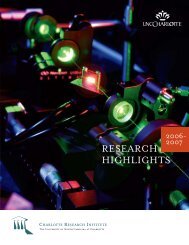rESEArCH HIGHLIGHTS - Charlotte Research Institute - University ...
rESEArCH HIGHLIGHTS - Charlotte Research Institute - University ...
rESEArCH HIGHLIGHTS - Charlotte Research Institute - University ...
Create successful ePaper yourself
Turn your PDF publications into a flip-book with our unique Google optimized e-Paper software.
dominant interior of a living cell. Funded by grants from the National Science Foundation (NSF) andNational <strong>Institute</strong>s of Health (NIH), these types of electrostatic interactions are being computationallymodeled by a CBES team consisting of Drs. Wei Cai and Shaozhong Deng (Mathematics and Statistics)and Drs. Andrij Baumketner and Donald Jacobs (Physics and Optical Science). The team’s work willresult in novel numerical methods that quickly and accurately calculate these electrostatic interactionsfor a range of biomolecular simulations. Because electrostatic interactions of this type can directly influencethe performance of the proteins used in drug formulations, this research has the potential to impactbiomedical applications such as pharmaceutical design.An example of the research being done within the Center’s Biomechanics & Mobility area involves CBESresearcher Dr. Mitch Cordova, Chair of the Department of Kinesiology in the College of Health and HumanServices at UNC <strong>Charlotte</strong>. By partnering with Dr. Rick Peindl, and David Mauerhan of the Department ofOrthopaedic Surgery, and Drs. Flora Hammond and Mark Hirsch, (Director) of Orthopaedic Engineering<strong>Research</strong> in the Departments of Orthopaedic Surgery and Physical Medicine & Rehabilitation at CMC,this team is seeking to gain a better understanding of how degenerative joint disease of the knee influencesthe three sensory systems (i.e., visual, vestibular and somatosensory) that regulate and maintain posturalcontrol. This work essentially aims to: 1) establish the extent to which osteoarthritis negatively affects theknee joint’s contribution to a person’s ability to stand upright, and 2) establish if visual and vestibularfunction increases to control posture in an attempt to adjust for the knee joint’s reduced ability to do so. Amajor goal of this research is to develop quantitative tests that can be used not only for patient evaluation,but also to assess outcomes for a wide range of medical interventions in the lower extremity of the humanbody. As such, the research – which involves faculty, residents and graduate students — has the potential todirectly impact patient care.CBES is one illustration of UNC<strong>Charlotte</strong>’s commitment to 1)improving the quality of healthcarethrough biomedical research, and2) preparing a workforce to meetthe future healthcare needs of ournation, and thereby contributing toeconomic development.Drs. Chris Yengo (Biology) and Donald Jacobs (Physics & Optical Science) arecollaborating to examine conformational changes in the motor protein myosinthat drives the process of muscle contraction. Fluorescence spectroscopic measurements(CY) are used to examine structural transitions in myosin, which areintegrated with computational modeling to simulate motions (DJ). This researchwill further understanding of genetic diseases that disrupt myosin function, suchas Familial Hypertrophic Cardiomyopathy involving thickening of the heart wallsof the left ventricle.19U.S. Department of Labor statisticsproject massive job growth(31.4 percent through 2010) inbiomedical engineering in responseto an aging U.S. population.Typical career paths for biomedicalengineering graduates include workin medical device corporations,manufacturing, and academia.Visit www.CBES.uncc.edu.<strong>Research</strong> Highlights 2006-2007





